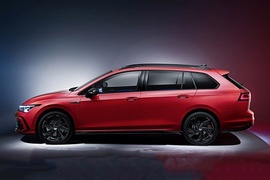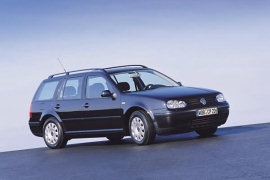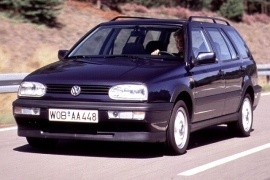
VOLKSWAGEN Golf Variant
Generations Timeline, Specs and Pictures

Based on the same MQB platform as the regular, eighth generation, of the Volkswagen Golf, the Variant was the station-wagon version for the well-known German compact car.
Ever since the third generation of the Volkswagen Golf, the German car-maker offered its most known product in a family version, with a bigger trunk area. While most of the credits are usually going for the 5-door or the 3-door versions, the station-wagon was very well sold all over the world.
The eighth generation of the Golf featured a slimmer front fascia, with narrow headlights extended on the upper side with “eyebrows” swept on the fenders. The front bumper featured a wide grill in the apron with horizontal slats that visually made the car looks wider. Up to the A-pillars, the car looked the same as the hatchback, but the longer roof and the back were different. A set of side windows was placed behind the rear door and the raked tailgate completed the car.
Inside, the Golf Variant featured the same dashboard as the regular Golf, with that clean look for the dashboard, uncluttered by too many buttons. The 8.25” touch-screen infotainment display was installed in a floating design trend, on top of the center stack, and close to the instrument cluster. The automatic gearbox selector was placed on the center console, like a mini-joystick.
Under the hood, the Golf Variant featured a mild-hybrid system powered by a turbocharged gasoline engine with direct fuel injection. It was mated to a 7-speed automatic transmission (DSG – dual-clutch).

Volkswagen unveiled the seventh generation of the Golf in 2012, and, like all its predecessors from the 3rd generation, it featured a station-wagon body version named Variant.
The Golf proved to be one of the most successful cars in history, since its introduction at the beginning of the ’70s. While the first generation was available only as a 3- and 5-door version, plus a convertible, only starting with the third generation, it was offered as a station-wagon as well. In 2016, at the Paris Motor Show, Volkswagen introduced a facelifted version for the Golf’s seventh generation.
At the front, a chromed bar ran across the grille and inside the headlights. The same bar was red for the GTI and blue for the GTE. The front lower apron was redesigned and featured a wider, A-shaped opening. A new option for LED headlights was added to the list, while the taillights received standard LEDs. Just like the Passat Variant, the Golf Variant was also available with trapezoidal chrome trim panels, directly integrated into the diffuser, as an option.
Inside, the 2017 Golf Variant featured new trim panels on the doors, the dash panel, and the center console. The car featured a new infotainment system with gesture control that was introduced for the first time in a Volkswagen production model. The new Active Info Display was a fully digital instrument cluster with interactive functions and a 12.3” color screen.
As usual, Volkswagen offered the Golf with a wide choice of engines. Its most powerful versions were not with gasoline but with diesel. Most engines were paired with either a 6-speed manual or a 7-speed automatic (dual-clutch system).

Volkswagen introduced the seventh generation of the Golf in 2012 and waited for another year before submitting the station wagon version named Variant.
Ever since the Golf’s third generation, the German carmaker named its station wagon as Variant, following the same tradition initiated by the Passat range. The new Golf was built on the scalable MQB platform, shared with many other cars within the Volkswagen group, from Audi to Skoda. In the station wagon shape, the Variant lost a few engines compared with the hatchback version but gained a few other features compared with its predecessor.
The Variant shared the same body panels up to the B-pillar with its five-door sibling. It featured the same angular-shaped front fascia with its angry-looking headlights narrower towards the car’s center grille. From its sides, the station wagon featured a more extended roofline and a slightly sloped-down upper window line creating a dynamic image for the car. Its third rear side window featured an angular shape on its lower side, before the D-pillar.
Inside, Volkswagen improved the quality of the material to a premium-like level, with a soft-touch dashboard and door panels. It featured a standard 5.8” touchscreen display while an 8” unit with a navigation system was on the options list. The carmaker installed a 60/40 split-folding seatback for the rear seats, which formed a completely flat area with the trunk floor. Thus, it increased the luggage space from 605 liters (21.4 cu-ft) to 1,620 liters (57.2 cu-ft). The car also offered an under-floor storage area.
Under the hood, the Golf Variant offered a wide engine choice between 85 hp and 150 hp. The versions under 122 hp featured a semi-rigid rear axle to cut production costs, while all the other versions offered an independent suspension. Volkswagen presented the Golf VII Variant with a standard electronically controlled differential, which mimicked a self-locking type one. Another first-of improvement was the option for adaptive dampers. For specific engine versions, Volkswagen installed an all-wheel-drive (4Motion) system with a Haldex center differential.

Volkswagen launched the Golf Variant (station-wagon) at the 2007 Geneva Motor Show.
It was an expected member of the family. Some might said it was an awaited version.
While the market trend started to switch from MPV to crossover and SUVs, Volkswagen and other carmakers still insisted on the station wagon market as a true alternative, and that was a correct assumption. These kinds of vehicles offered better running costs than the crossovers and the MPVs and still offered enough interior room for a family with a toddler.
The Golf V was a great success thanks to its design and the engineering inside it. The angled headlights with bigger lamps inside and the body’s fluid lines made it an instant hit. It was developed with some concessions for the design, but nothing to worry about. It lost fewer points in practicality than it gained on the image. It was 36 cm (14.2”) longer than the hatchback version due to the extra luggage area. Unlike its predecessor, the tailgate and the D-pillars were raked to improve the car’s look.
Inside, the Golf V’s dashboard was plain and simple, with a big center console between the driver and the passenger. The blue, back-lit instrument cluster was easy to read and comforting on long driving roads. On the center stack, depending on the option, the manufacturer installed a CD-radio for the base models or a complete infotainment unit with a sat-nav system. The rear passengers could sit well thanks to the longer roofline that offered enough headroom. The Golf Variant was fitted as standard with a split-folding seatback for the bench to expand the storage area.
Under the hood, Volkswagen installed a wide choice of diesel and gasoline engines with a power ranging between 80 hp and 170 hp.

Volkswagen introduced the Golf’s sixth-generation at the Paris Motor Show in October 2008, and it was one of the most awaited novelties of the year in the motoring industry.
The world economic crisis already claimed its first victims, and the carmakers were struggling to survive, but Volkswagen didn’t look too concerned about that. It just tried to keep its promises for its fans and introduced a successor for the Golf’s fifth generation. At the Motor Show, the German carmaker showed only the hatchback forms while the station wagon appeared in May 2009. One of the reasons why Volkswagen had to change or improve the car was the introduction of the Euro 5 emission levels.
From the outside, it was hard to tell that it was more of a heavy facelifted model. But it featured the same technical platform and the same wheelbase as its predecessor. Its headlights swept-back and angled showed an angry look next to the two-slat grille that supported the chromed VW badge in the middle. Its roofline was longer than on the hatchback and made room for an additional set of windows and an extended quarter panel behind the rear doors. Its tailgate was slightly raked forward in a curved shape toward the bumper.
Inside, the Golf VI Variant featured a similar interior with its siblings but with access to a bigger trunk. By folding down the rear seats, it could increase the storage size from 505 liters (17.8 cu-ft) to 1495 liters (52.8 cu-ft).
Under the hood, Volkswagen installed a very wide range of engine and drivetrain options ranged between 85 hp and 160 hp, with front- or all-wheel-drive. Depending on the engine choice, it was available with a manual or a seven-speed automatic (dual-clutch) transmission.

First introduced in 1999 and part of the fourth generation of Volkswagen Golf, the Golf IV Variant was only assembled at the Volkswagen factory located in Wolfsburg, Germany.
Equipped with a large number of engine versions, such as the 1.4 liter 16V, 1.8 liter turbocharged or the 1.9 liter TDI, this vehicle was kept in production until 2006 when Volkswagen rolled out an upgraded model called Golf V Variant, part of the fifth generation of Golf. Also known as Volkswagen Bora Variant, this model was equipped with a 5- or 6-speed manual transmission as well as with a 4- or 5-speed automatic transmission.

Volkswagen introduced the third generation of the Golf in 1991, and it took it two years to decide and launch it as a station wagon as well.
The Golf was already a cult car after millions of cars produced from the first two generations. As a result, every fan awaited the new generation. While some were happy with the change, others said that it’s not the same Golf anymore. Indeed, it was bigger, wider, and focused more on comfort than on sportiness. But it was a much better car. In the station wagon form, it was, at last, a true compact vehicle for the young generation with kids.
Volkswagen’s designers threw away the round headlights from its predecessors and adopted wider lamps with a rounded interior side. The grille got smaller, and the bumpers got bigger, stretched from one wheel-well to another. In station wagon form, the Golf Variant featured different rear doors and an additional set of windows between the C- and the D-pillars. In the back, the flat, vertical tailgate allowed easier access to the big trunk.
Inside, Volkswagen installed a curved dashboard with a taller, tilted toward the driver, center stack. The instrument cluster kept a similar layout with four dials, but the carmaker introduced a small LED display at the bottom. For the base trim levels, the Golf III featured cranked windows and manually adjustable door-mirrors. The upper trim levels featured power mirrors, windows, and locks. In the rear, Volkswagen installed a split-folding bench that could extend the trunk size from 466 liters (16.46 cu-ft) to 1428 liters (50.36 cu-ft).
Volkswagen installed a wide range of powertrains, with front or all-wheel-drive systems. Power ranged between 60 hp and 190 hp for the gasoline versions and 64 hp to 110 hp for the diesel ones.























































